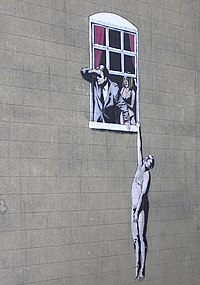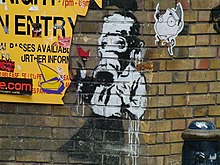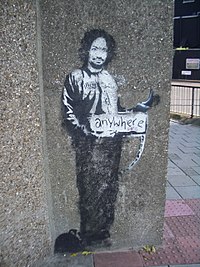| Revision as of 20:25, 29 November 2006 view sourceArpingstone (talk | contribs)Extended confirmed users, Pending changes reviewers, Rollbackers39,444 edits The Gillette para is irrelevant to Banksy so removed. Israel para removed (the Flickr URL doesn't work so info can't be checked)← Previous edit | Revision as of 11:51, 30 November 2006 view source Wnjr (talk | contribs)Extended confirmed users1,528 editsm restore Israel para, flickr url is fineNext edit → | ||
| Line 67: | Line 67: | ||
| The Los Angeles Coagula Art Journal commented on the Banksy phenomenon by featuring twenty pages of photos depicting local contemporary artists holding signs that read "Nothing About Banksy in this Issue". | The Los Angeles Coagula Art Journal commented on the Banksy phenomenon by featuring twenty pages of photos depicting local contemporary artists holding signs that read "Nothing About Banksy in this Issue". | ||
| Banksy’s technique for never getting caught is several look-outs surrounding him. According to when Banksy scaled the 425-mile wall in ], many of the onlookers were just waiting for him to fall off and as soon as there were signs of soldiers, the “lookouts” took off, leaving Banksy high and dry. Not everyone in the ] appreciates his work, just like the people in ] who still consider the graffiti to be vandalism. One Palestinian remarked that Banksy was making the wall beautiful and when Banksy thanked him the man replied, “We don’t want it beautiful. Go home.” | |||
| ==Reviews and comments== | ==Reviews and comments== | ||
Revision as of 11:51, 30 November 2006
Banksy (1974- ) is a world renowned, Bristol-based graffiti artist whose artwork is often political and/or humorous in nature.
His street art, which combines graffiti with a distinctive stencilling technique, has appeared in London and in cities around the world. Publicity in the media has made his name well known.
Work
Banksy started as a freehand graffiti artist then discovered the art of stencilling, and soon became noticed for his art.
Banksy's stencils feature striking and humorous images occasionally combined with slogans. The message is usually anti-war, anti-capitalist, anti-establishment or pro-freedom. Subjects include animals such as monkeys and rats, policemen, soldiers, children and the elderly. He also makes stickers (the Neighbourhood Watch subvert) and sculpture (the murdered phonebox), and was responsible for the cover art of Blur's 2003 album Think Tank.
In 2003 in a show called 'Turf War', held in a warehouse, he painted on animals. Although the RSPCA declared the conditions suitable, an animal rights activist chained herself to the railings in protest.
He has moved on to producing subverted paintings; one example is Monet's Water Lily Pond, adapted to include urban detritus such as litter and a shopping trolley floating in its reflective waters, another is Edward Hopper's Nighthawks, redrawn to show that the characters are looking at an English football hooligan dressed only in his Union Flag underpants, who has just thrown an object through the glass window of the cafe. These oil paintings were exhibited at a twelve day exhibition in Westbourne Grove, London in 2005.
In 2006, Banksy held an exhibition called Barely Legal, billed as a "three day vandalised warehouse extravaganza" in Los Angeles on the weekend of 16 September. The exhibition featured a live 'elephant in a room', painted in a floral wallpaper pattern.
After Christina Aguilera bought an original of Queen Victoria as a lesbian and two prints for £25,000 , on 19 October, 2006 a set of Kate Moss paintings sold in Sotheby's London for £50,400, setting an auction record for Banksy's work. The six silk-screen prints, featuring the model painted in the style of Andy Warhol's Marilyn Monroe pictures, sold for five times its estimated value. His stencil of a green Mona Lisa with paint dripping from her eyes sold for £57,600 at the same auction .
Art stunts
Banksy has claimed responsibility for a number of high profile stunts. These include the following:
- At London Zoo, he climbed into the penguin enclosure and painted 'We're bored of fish' in two metre high letters.
- At Bristol Zoo, he left the message 'I want out. This place is too cold. Keeper smells. Boring, boring, boring.' in the elephant enclosure.
- In January 2001, he traveled to the areas controlled by the Zapatista Army of National Liberation in Chiapas, Mexico, and in sign of solidarity with their movement, painted murals with scenes depicting the struggle and also made stencils on the walls of San Cristóbal de las Casas.
- In March 2005, he placed subverted artworks in the Museum of Modern Art, Metropolitan Museum of Art, the Brooklyn Museum, and the American Museum of Natural History in New York.
- He put up a subverted painting in London's Tate Britain gallery.
- In May 2005 Banksy's version of a primitive cave painting depicting a human figure hunting wildlife whilst pushing a shopping trolley was found hanging in the British Museum, London. Upon discovery, the museum added it to their permanent collection.
- In August 2005, Banksy painted 9 images on the Palestinian side of the Israeli West Bank barrier, including an image of a ladder going up and over the wall and an image of children digging a hole through the wall .
- In April 2006, Banksy created a sculpture based on a crumpled red phone box with a pickaxe in its side, apparently bleeding, and placed it in a street in Soho, London. It was later removed by Westminster Council. BT released a press release, which said: "This is a stunning visual comment on BT's transformation from an old-fashioned telecommunications company into a modern communications services provider."
 |
- In June 2006, Banksy created an image of a naked man hanging out of a bedroom window on a wall in central Bristol. The image sparked some controversy, with the Bristol City Council leaving it up to the public to decide whether it should stay or go. After an internet discussion in which 97% (all but 6 people) supported the stencil, the city council decided it would be left on the building.
- In August/September 2006, Banksy replaced up to 500 copies of Paris Hilton's debut album, Paris, in 48 different UK record stores with his own cover art and remixes by Danger Mouse. Music tracks were given titles such as "Why am I Famous?", "What Have I Done?" and "What Am I For?". Several copies of the CD were purchased by the public before stores were able to remove them, some going on to be sold for as much as £750 on online auction websites. The cover art depicted Paris Hilton digitally altered to appear topless. Other pictures feature her with a dog's head replacing her own, and one of her stepping out of a luxury car, edited to include a group of homeless people, which included the caption 90% of success is just showing up.
- In September 2006, Banksy dressed an inflatable doll in the manner of a Guantanamo Bay detainment camp prisoner (orange jumpsuit, black hood, and handcuffs) and then placed the figure within the Big Thunder Mountain Railroad ride at Disneyland theme park in Anaheim, California.
Technique
Some stencils are created by using a computer to generate an image, and by utilizing a photo editing program to break down that image into layers, which are then subsequently printed and cut to be painted as the multiple layers of a stencil. Many stencil graffiti artists, including Banksy, hand draw and hand cut picture layers onto a medium such as cardboard or acetate, and, by using free-hand techniques such as shading, create highly detailed images that are quickly applied. This allows a stencil artist to incorporate far more detail into a small piece of work than a free-hand artist can, often in a piece ten times the size.
Real identity
Although he has tried to hide his identity, according to The Guardian his real name is Robert Banks , born in 1974 in Bristol, England; while the BBC says it's Robin Banks .
Simon Hattenstone from Guardian Unlimited is still, today, one of the only people to interview Banksy face-to-face. In Hattenstone's interview with Banksy he appears to be a cross of JimmyNail and British rapper Mike Skinner. According to Hattenstone, Banksy is a white 28 year old who showed up wearing jeans and a t-shirt with a silver tooth, silver chain, and one silver earring.
The registrant of Banksy's website is Steve Lazarides, a photographer. Lazarides is Banksy's agent. Lazarides now has a gallery on Greek St in London's Soho called Laz Inc, where Banksy originals can be bought. The website - picturesonwalls.com has the exclusive sale rights for all of Banksy's limited edition prints.
A Brian Sewell spoof website claims to show a photograph of Banksy. Banksy's parents think their son is a painter and a decorator.
Controversy

Peter Gibson, spokesperson for Keep Britain Tidy, asserts that Banksy's work is simple vandalism. The political purpose behind his 'vandalism' is reminiscent of the Ad Jammers or subvertising movement, who deface corporate advertising to change the intended message and hijack the advert.
Banksy does paid work for charities (e.g., Greenpeace) and can demand up to £25,000 for canvases. It has also been alleged that Banksy has done paid work with corporations such as Puma although this has been denied. This has led to him being accused of being a sellout and a careerist by other artists and activists.
Due to his subversive character; Banksy has achieved somewhat of a cult following from some of the younger age group within the stencilling community.
In 2004 the Space Hijackers gave out spoof vouchers outside a Banksy exhibition to highlight the artist's arguably hypocritical use of anti-capitalist and protest imagery while doing work for corporations and art galleries.
The Los Angeles Coagula Art Journal commented on the Banksy phenomenon by featuring twenty pages of photos depicting local contemporary artists holding signs that read "Nothing About Banksy in this Issue".
Banksy’s technique for never getting caught is several look-outs surrounding him. According to Flickr’s Banksy discussion when Banksy scaled the 425-mile wall in Israel, many of the onlookers were just waiting for him to fall off and as soon as there were signs of soldiers, the “lookouts” took off, leaving Banksy high and dry. Not everyone in the Middle East appreciates his work, just like the people in Europe who still consider the graffiti to be vandalism. One Palestinian remarked that Banksy was making the wall beautiful and when Banksy thanked him the man replied, “We don’t want it beautiful. Go home.”
Reviews and comments

- "He does all this and he stays anonymous. I think that's great. These days everyone is trying to be famous. But he has anonymity" - Brad Pitt
- "Banksy has never let the world know his real name - and he has never even posed for a photograph. Funny kind of celebrity" - Paul Vallely in The Independent.
- "...he's often feted as a genius straddling the bleeding edge of now. Why? Because his work looks dazzlingly clever to idiots. And apparently that'll do" - Charlie Brooker
Bibliography
Banksy has also self-published several books that contain photos of his work in various countries as well as some of his canvas work and exhibitions, accompanied by his own writings. His first book, published in black-and-white, is Banging Your Head Against A Brick Wall followed by the full colour Existencilism. In 2004 he published his third book, Cut it Out. Random House published Wall and Piece in 2005. It contained a combination of images from his three previous books, as well as some new material.
References
- ^ Banksy. Wall and Piece. Random House. Retrieved 2006-09-19.
- "Animals sprayed by graffiti artist". BBC NEWS. 2003-07-18. Retrieved 2006-09-19.
- "Banksy Show Tonight in London". 2005-10-13. Retrieved 2006-09-19.
- "'Guerrilla artist' Banksy hits LA". BBC NEWS. 2006-09-14. Retrieved 2006-09-19.
- "Aguilera invests £25,000 in Banksy". Independent. 2006-04-06. Retrieved 2006-10-20.
- "Banksy works set auction record". BBC NEWS. 2006-10-20. Retrieved 2006-10-20.
- ^ Manco, Tristan. Stencil Graffiti. Thames & Hudson. ISBN 0-500-28342-7. Retrieved 2006-09-19.
{{cite book}}: Unknown parameter|origmonth=ignored (help) - "A Wooster Exclusive: Banksy Hits New York's Most Famous Museums (All of them)". 2005-03-23. Retrieved 2006-09-19.
-
Jeff Howe. "Art Attack". Wired (13.08). Retrieved 2006-09-19.
{{cite journal}}: Unknown parameter|datemonth=ignored (help); Unknown parameter|dateyear=ignored (help) - "Art prankster sprays Israeli wall". BBC NEWS. 2005-08-05. Retrieved 2006-09-19.
- Sam Jones (2005-08-05). "Spray can prankster tackles Israel's security barrier". The Guardian. Retrieved 2006-09-19.
- "Artist's cold call cuts off phone". BBC NEWS. 2006-04-07. Retrieved 2006-9-19.
{{cite news}}: Check date values in:|accessdate=(help) - ^ "Artist's saucy stencil for city". 2006-06-21. Retrieved 2005-09-19.
- "Paris Hilton targeted in CD prank". BBC NEWS. 2006-09-04. Retrieved 2006-09-19.
- Claire Truscott (2006-09-03). "Banksy targets Paris Hilton". The Independent on Sunday. Retrieved 2006-09-19.
{{cite news}}: Unknown parameter|coauthors=ignored (|author=suggested) (help) - "Paris Prank Confirmed". 2006-09-07. Retrieved 2006-09-19.
- "BREAKING: The story Disneyland doesn't want you to know". 2006-09-08. Retrieved 2006-09-19.
- "Artist Banksy targets Disneyland". BBC NEWS. 2006-09-11. Retrieved 2006-09-19.
- Vikram Dodd (2004-04-08). "Natural History Museum exhibits an unnatural specimen". The Guardian. Retrieved 2006-09-19.
- BBC
- "Banksy revealed?". Retrieved 2006-09-19.
- Simon Hattenstone (2003-07-17). "Something to spray". The Guardian. Retrieved 2006-09-19.
- "Banksy, Pictures On Walls & Puma snuggling up?". Retrieved 2006-09-19.
- Banksy: The joker
- Supposing ... Subversive genius Banksy is actually rubbish Guardian Unlimited 2006-22-09. Retrieved 2006-02-11.
External links
- Banksy's website
- Banksy Ebay Group - Original Banksy Discussion Group
- Banksy.info - Banksy Fans Forum
- Banksy at Flickr!
- Banksy at Buzznet!
- Banksy on artofthestate - over 350 Banksy photos
- Article on Wall and Piece
- Galleries of Banksy's work: ekosystem.org, Banksy on artofthestate - over 350 photos!, ghostboy.co.uk, pbase.com search, Jon Marsh
- Video reportage of the 'Illusive Banksy'
- Art Attack from Wired
- An article on the artist from Liverpool's 'Nerve' magazine
- Perry Ferrell interviews Shepard Fairey on Banksy's Art
- Simon Hattenstone interviews Banksy
- Flickr photoset of Banksy's Paris Hilton CD shop drop prank
- A Google Map of Banksy locations
- Radio story about Banksy from U.S. public radio program 'Marketplace'
- Guardian article, 17 Sept 2006, about Banksy